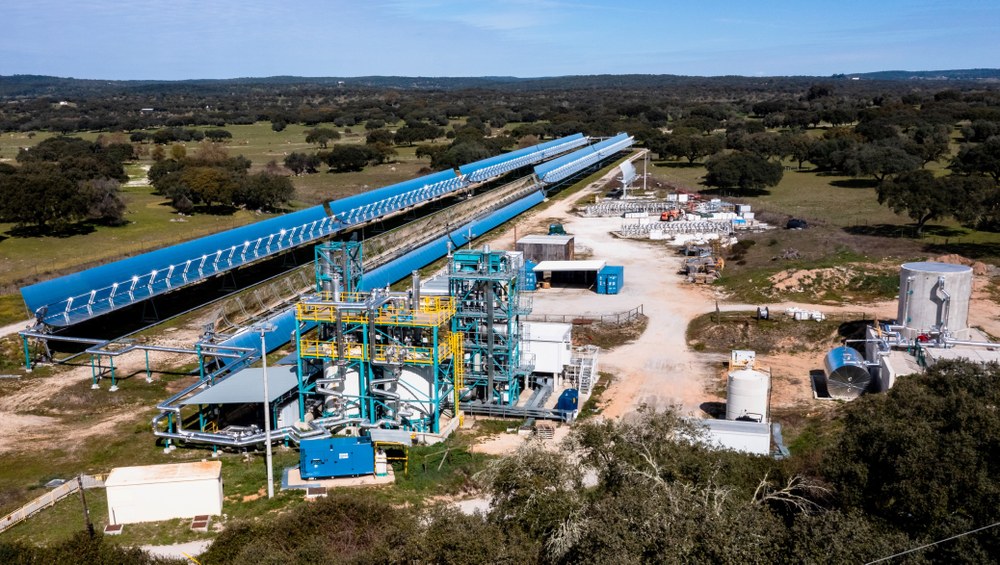Évora Molten Salt Platform (University of Évora)


The German Aerospace Center (DLR) and the University of Évora (UÉ, Portugal) jointly operate a test facility for molten salt technologies near the city of Évora, the Évora Molten Salt Platform (EMSP). The platform comprises various independent molten salt plants, the largest of which is a parabolic trough power plant. Except for the steam turbine and generator, it has all the relevant components of a commercial plant. This allows the key material, component and system-related aspects required for reliable and efficient operation of the molten salt plant to be analysed.
- Investigation of material wear due to corrosion and thermal cycles, thermal stability and ageing of salt mixtures,
- Demonstration of the reliability of critical components such as flexible
pipe connections in the solar field and the once-through steam generator with molten salt, - Evaluation of the performance of the collector system and the energy requirement for night and standby operation,
- Validate procedures to prevent salt freezing, to fill and drain the system, for blackout scenarios and to remove blockages caused by freezing,
- Development of alternative operating procedures to improve the reliability and/or cost efficiency of the system.
Focal points of the research work
Technical description of the system
The Évora Molten Salt Platform has a solar field, a salt storage system, a steam generator with a connected water-steam cycle as well as a control system and auxiliary equipment. In the solar field, parabolic trough collectors of the HelioTrough® 2.0 type with a large aperture from a circuit that is suitable for operation with molten salt up to 565 degrees Celsius. The collectors are arranged in two rows with a large aperture. The collectors are installed in two rows with a total length of 684 metres and are designed for a maximum thermal output of around 3.5 megawatts. The salt system comprises a hot and a cold storage tank, an underground dewatering tank with a salt melting system as well as pumps and valves to control the various operating modes. The steam generator has a design capacity of 1.8 megawatts thermal at 140 bar/560 degrees Celsius. Pressure and temperature reducing stations and an air-cooled condenser are installed in the water-steam system instead of a steam turbine.
A versatile test facility for concentrating solar thermal technologies
The EMSP makes it possible to investigate and validate a wide range of innovations in a relevant environment. Not only can we investigate molten salt as a heat transfer and storage medium here, but we can also demonstrate the interaction of various new power-to-heat technologies.
In 2021, 90 tonnes of the ternary salt Na-K-Ca-NO3 were melted in a pre-melting unit and the plant was successfully commissioned with this salt for the first time. Compared to the commonly used solar salt, the ternary mixture has a significantly lower melting temperature of 130 degrees Celsius, but can only be used up to around 500 degrees Celsius. After a phase of optimization and troubleshooting, the feasibility of the technology was proven with more than 5500 operating hours at 500 degrees Celsius.
In the subsequent MSOpera project funded by the BMWK (German Federal Ministry for Economic Affairs and Climate), operation at 565 degrees Celsius was successfully demonstrated. For this purpose, the salt used until then was replaced by the binary salt mixture Na-K-NO3 (solar salt), which can reach a maximum temperature of 565 degrees Celsius. The maximum temperature of the system is limited by the austenitic steels and the decomposition temperature of the binary salt. To maintain the critical maximum temperature, DLR has developed an improved control concept which uses a validated dynamic model of the solar field.
As part of MSOpera, a salt dilution process was also successfully tested to shut down the system for the salt change. This process is also of interest for other applications: the DLR team is investigating the possibility of using diluted molten salt as a heat transfer medium in the winter months and also for night-time operation in order to reduce heat losses.
In the MSOpera and EuroPaTMoS projects, a solar preheating process for pipes was tested as a means of preventing the salt from solidifying and the pipes from clogging. Preheating the pipes is always necessary when salt is filled into an empty pipe. Modern systems preheat the pipes using electricity. However, this method requires a high level of investment, as long cables have to be laid through the solar field. It also incurs high operating and electricity costs. These costs can be avoided by utilizing the sun. However, there is a risk of overheating with solar pre-heating: the solar heat generated by the huge mirrors can overheat and even destroy the empty heat collecting element (HCE) within a few seconds. Two different methods of solar preheating were developed and tested at the EMSP. In order to monitor the correct process and temperature rise of the solar collector, a draw-wire sensor was developed with good accuracy to keep the process and temperature gradients within specifications. DLR, together with industrial companies, has shown that adequate heating to the desired temperature can be achieved within the permissible temperature gradient limits.
Further national and international third-party-funded projects have already been approved and are in preparation until 2027.

24/7 operation of the system with solar salt
In order to reduce the operating costs of the plant, the DLR team has developed a logic and control system that enables unmanned operation of the plant at night. The logic performs the typical tasks of human operators who monitor the plant, identify critical plant conditions, initiate countermeasures and escalate interactions when early countermeasures fail. This system was developed, programmed, uploaded and successfully tested in the binary salt circuit. Today, the facility is manned by human operators during the day to run scientific test programmes. The human operators activate the unmanned mode at the end of the shift. The control system takes over the 16-hour night shift or even monitors the plant over the weekend until Monday morning.
